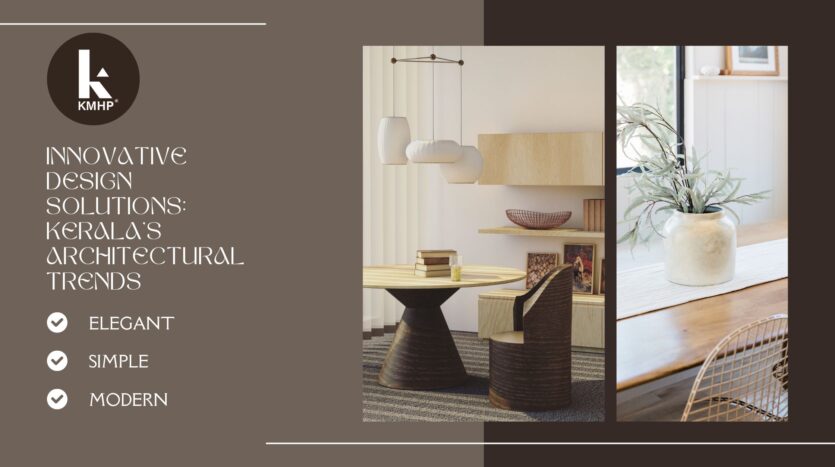Kerala’s architectural landscape is a rich history of traditional buildings and innovative design solutions. Kerala in India is known for its natural beauty, cultural heritage and vibrant architecture. Kerala’s architecture is a reflection of its unique cultural identity and the diverse influences it has experienced over time. In recent years, the architecture of Kerala has evolved to embrace new technologies, eco-friendly building techniques, and innovative materials. This article will provide an overview of Kerala’s architectural trends, highlighting traditional and contemporary designs, eco-friendly building techniques, integration of technology, and future directions for the architecture of Kerala.

Traditional Architecture and Design in Kerala
Distinctive Features of Kerala’s Traditional Architecture
Kerala’s traditional architecture is characterized by several distinctive features such as sloping roofs, wooden pillars, and use of natural materials like clay, timber, and stones. The sloping roofs are designed to withstand the heavy monsoon rains and promote cross-ventilation. The wooden pillars are intricately carved with images from Hindu mythology and are meant to symbolize strength and stability.
Examples of Traditional Architecture in Kerala
Some of the popular examples of traditional architecture in Kerala include the Padmanabhapuram Palace, the Krishnapuram Palace, and the Mattancherry Palace. These palaces are known for their stunning architecture, intricate carvings, and use of natural materials.
Contemporary Design Solutions in Kerala
Emergence of Contemporary Architecture in Kerala
In recent years, Kerala has witnessed a surge in contemporary architecture that blends traditional and modern design elements. The emergence of contemporary architecture in Kerala is a response to the changing lifestyle needs of the people. Contemporary homes in Kerala are designed to be functional, eco-friendly, and aesthetically pleasing.
Contemporary Architectural Styles and Trends in Kerala
Some of the popular contemporary architectural styles and trends in Kerala include minimalist design, use of glass facades, and incorporation of elements from traditional architecture. Many contemporary homes in Kerala also feature eco-friendly design solutions such as rainwater harvesting, solar panels, and use of natural materials.
Eco-friendly Building Techniques in Kerala
Importance of Eco-friendly Building Techniques in Kerala
Kerala’s abundant natural resources and diverse climate make it an ideal location for eco-friendly building techniques. Eco-friendly building practices not only reduce the carbon footprint but also promote sustainable development. Kerala’s eco-friendly building techniques have become an inspiration for architects and designers around the world.
Examples of Eco-friendly Building Techniques in Kerala
Some of the popular examples of eco-friendly building techniques in Kerala include rainwater harvesting, use of solar panels, and use of natural materials like bamboo and mud bricks. The state also promotes green building certification programs to encourage sustainable building practices. Kerala’s innovative design solutions have made it a leader in sustainable building practices in India.
Innovative Use of Materials in Kerala’s Architecture
Kerala is known for its rich cultural heritage and traditional architecture. However, in recent years, the state has witnessed an influx of innovative design solutions that merge traditional elements with modern materials. The use of innovative materials in Kerala’s architecture not only enhances the aesthetic value of buildings but also improves their functionality and sustainability.
Introduction to Innovative Materials Used in Kerala
Kerala’s architecture has always relied on locally available materials such as wood, bamboo, and clay. However, with the advent of new technology, materials such as concrete, glass, and steel have gained popularity. These materials not only offer greater structural stability but are also more durable, cost-effective, and have a lower carbon footprint.
Examples of Innovative Materials Used in Kerala’s Architecture
One of the most prominent examples of innovative use of materials in Kerala’s architecture is the Jatayu Earth Center in Kollam. The entire structure is made of steel and concrete and is shaped like a giant bird. The intricate detailing of the bird’s feathers is made of fiberglass and resin. Another example is the Tangasseri Lighthouse in Kollam, which has a unique facade made of red and white ceramic tiles.
Integration of Technology and Architecture in Kerala
Kerala’s architectural trends have also witnessed a significant integration of technology. Architects and designers are incorporating smart technologies and automation systems to optimize energy consumption and enhance the overall user experience.
Importance of Technology in Kerala’s Architecture
Technology plays a crucial role in Kerala’s architecture, especially with the increasing focus on sustainability. Architects are using computational design tools and algorithms to optimize building performance and reduce the carbon footprint. Technology is also being used to create immersive experiences for users, such as virtual reality simulations.
Examples of Innovative Technology Used in Kerala’s Architecture
The Cochin International Airport’s Terminal 3 is one of the most technologically advanced airports in India. It has a fully automated baggage handling system and uses natural lighting and ventilation to reduce energy consumption. Another example is the HiLITE Mall in Calicut, which incorporates an intelligent building management system to control lighting, air conditioning, and security.
Importance of Sustainability in Kerala’s Architecture
Sustainability is a key consideration in Kerala’s architectural trends. With the growing awareness of climate change and environmental degradation, architects and designers are focusing on creating structures that are eco-friendly and energy-efficient.
Impact of Sustainability in Kerala’s Architecture
Sustainable architecture has a significant impact on Kerala’s environment. By using renewable energy sources such as solar power and wind energy, buildings can reduce their carbon footprint and dependence on non-renewable sources of energy. Sustainable architecture also promotes the use of locally sourced materials and reduces waste during construction.
Examples of Sustainable Architecture in Kerala
The Green Earth Heritage Museum in Calicut is a prime example of sustainable architecture in Kerala. The museum uses natural ventilation and lighting to reduce energy consumption and has a rainwater harvesting system to conserve water. Another example is the Utsavamandapam in Thrissur, which is a traditional performance space that uses natural materials such as wood and coconut leaves.
Future Directions for Kerala’s Architectural Trends
Kerala’s architectural trends are constantly evolving. Architects and designers are exploring new avenues and pushing the boundaries of traditional architecture to create structures that are innovative, sustainable, and user-friendly.
Challenges and Opportunities in Kerala’s Architecture
Kerala’s architectural trends face several challenges, such as the shortage of skilled labor and the high cost of materials. However, with the increasing demand for sustainable and eco-friendly structures, there are ample opportunities for architects and designers to create innovative solutions that are cost-effective and socially responsible.
Future Directions and Trends in Kerala’s Architecture
The future of Kerala’s architecture lies in the integration of traditional elements with modern technology and materials. Architects and designers are experimenting with new materials such as bamboo composites and incorporating renewable energy sources such as geothermal energy. There is also a growing interest in adaptive reuse of existing structures and heritage buildings. The future of Kerala’s architecture is indeed exciting, with endless possibilities for innovation and sustainability.Kerala’s architecture is a testament to the state’s rich cultural heritage and ingenuity. From traditional buildings to contemporary design solutions, Kerala’s architecture continues to evolve and adapt to meet the demands of the modern world. The integration of new technologies, eco-friendly building techniques, and innovative materials ensures that Kerala’s architecture remains at the forefront of design innovation. As Kerala continues to grow and evolve, the architecture of the state will undoubtedly continue to play a crucial role in shaping its future.


